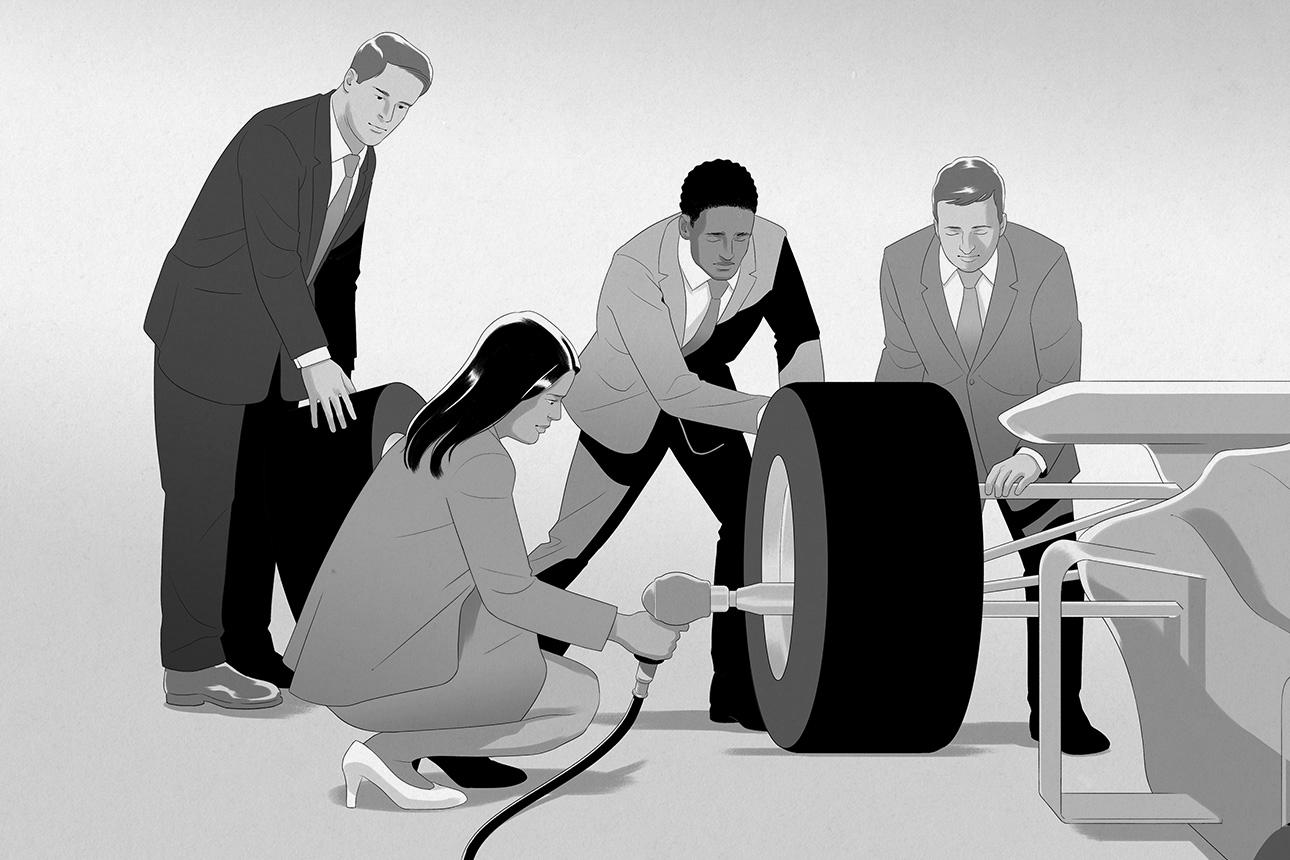Anuj Shrestha
Leading organizational change according to the conventional management playbook is difficult and often frustrating, and such efforts rarely stay on track. Executives set out with the sound ambition to transform traditionally hierarchical and siloed organizations into more agile, collaborative, and innovative ones: They formulate a compelling vision, communicate it, and try to inspire employees to do what’s required to achieve it. But they often find that people resist change, even when they agree that it’s needed. The top-down approach rarely wins engagement and commitment to a new vision.
In our hard-won experience in organizational transformation projects at several companies, we found that the idea of large-scale transformation can leave employees feeling overwhelmed and insecure about their ability to thrive in the new order. But we learned that by deploying a strengths-based approach at the individual level and then using it to constitute and manage diverse teams, we could win employee commitment to transformation. This approach can help reduce anxiety and burnout, increase inclusive and collaborative behaviors, and cut across hierarchical and functional boundaries. It creates agents of change with the power to contribute to a shared purpose and bold ambition rather than victims of change who feel powerless and fearful.
Get Updates on Transformative Leadership
Evidence-based resources that can help you lead your team more effectively, delivered to your inbox monthly.
Please enter a valid email address
Thank you for signing up
All of those outcomes contribute to a stronger culture of innovation in the organization that enables it to continually adapt to changing market conditions and meet new stakeholder demands. As one of us (Linda) has found over decades of research on leading innovation, it’s not about getting people to follow you to the future — it’s about getting them to cocreate it with you.1
In this article, we’ll explain how we developed our approach, the outcomes and impacts we observed, and what we learned along the way.
Wanted: Capabilities and Courage
Our experiences are rooted in the competitive life sciences sector, where the primary challenge facing leaders is the need to make companies more agile and able to innovate at scale and with speed. At each organization, we sought to lay a strong foundation for transformation by declaring ourselves to be “impact first” and working with employees to cocreate the purpose, vision, and strategic impact goals. We knew that executing on this vision would mean adopting a more democratic approach to innovation that would tap every individual’s capability and effort. In particular, we would need to involve employees who were closer to customers in problem-solving and decision-making.
At one organization, individuals across levels had rarely been expected or encouraged to solve problems and innovate; most of them did not think of innovation as a part of their job. Now they were suddenly expected to frame the right questions, hypothesize about future possibilities, critically analyze data for useful insights, and trust their intuition in the face of inadequate or no data. They needed confidence in their own capabilities in order to generate options for solutions. And they needed the courage to express their ideas in the face of divergent opinions and legitimate criticism.
This expectation of individuals to become evolved leaders themselves, and to coach and enable their teams to do the same, was a new and anxiety-provoking experience for many employees. Many had, up until then, been told what to do and to not deviate from instructions. There was already heightened insecurity coming from uncertainty in the business, changing structures and roles, and the need to adopt emerging technologies. People were uncertain about their own place in the organization of the future. A natural reaction for many in this situation was to hunker down and self-preserve, but what was needed, in fact, was greater courage, risk-taking, leaning in, and speaking out. The question before us was, in this context, how should we create such evolved leadership behavior across levels and enable individuals to do their best?
In order to gain employees’ engagement in collaboration, experimentation, and learning, we would need to help them gain awareness of the impact they could have and gain the confidence they needed to take the initiative and make decisions with a greater sense of ownership. That objective led us to the foundation of our approach: strengths-based performance management.2
Building Diverse Teams on Strengths-Based Management Principles
The classic Gallup strengths-based approach to employee development emphasizes identifying where individuals excel and supporting those strengths rather than focusing on shoring up areas of weakness as “development opportunities.”3 Employees tend to experience that strategy as empowering and providing them with a solid foundation for growth, in contrast with the often demotivating experience of being directed to remedy one’s shortcomings.4
The classic Gallup strengths-based approach to employee development emphasizes identifying where individuals excel.
In one organization, we had the employees complete the Gallup StrengthsFinder assessment and develop strengths-based individual development plans in consultation with their line managers. Then they created team strengths charts to identify the complementary and varied strengths that they had within their teams, and we encouraged them to find opportunities to leverage one another’s strengths. In another organization, we used the results and insights from StrengthsFinder to run monthly workshops for project teams on how to leverage their own strengths as individuals and others’ as leaders. We then showed them how complementary strengths could be applied to help build the strongest, most effective teams.
In setting up teams, each project lead was asked to think about and define both the skills and the strengths needed to achieve the desired impact as it related to a specific business priority the strategy creation process had identified. Teams were formed by aligning the strengths of available individuals with the strengths needed to deliver on the objective. A great deal of attention was paid to having diverse and complementary strengths on each team. Project leads were coached to refer to the strengths of their team members in meetings, which built mutual awareness of others’ capabilities and reinforced the importance of considering people’s strengths. We heard from leaders who participated in this process that it opened their eyes to the importance of diverse points of view, expertise, and experience, as well as their responsibility to create safe spaces for expressing differing viewpoints and to keep an open mind. This set the stage for them to be ready to lead the agile teams that we envisioned.
Building Identity Around Strengths
We chose to make strengths-based teams the building block for driving innovation, and hence transformation, as a way to “change the world one room at a time,” as expressed by the author Peter Block.5 That is, we came to see that we had to shift the collective narrative one person and one team at a time. However, these teams would demand a new level of collaboration that our employees weren’t accustomed to and hadn’t been prepared for in a larger culture that emphasized competition. It was also possible that establishing the cross-functional, cross-hierarchical teams we needed would result in conflict that could derail the transformation. But composing teams based on diverse and complementary strengths made all the difference.6
First, because each individual knew their strengths, they knew why they were on the team and felt like a valuable team member. Knowing that every other member similarly brought other strengths to the team helped individuals see others as equally valuable and spawned a desire to collaborate. People engaged with one another through the lens of strengths, without getting bogged down by differences of opinion. It helped them see debate as what it was: creative abrasion that generated higher-quality outcomes and decisions.
To enable all of this to happen, we actively socialized the focus on strengths. We made it a central part of people’s identity in the organization via simple tactics like asking all employees to add their strengths to their email signatures. This encouraged people to become curious about others’ strengths in a positive, nonthreatening, noncompetitive way. We also had teams create team strengths charts that visually represented the range of diverse and complementary strengths within the team. All employees and managers were asked to put the individual strength profile of each employee at the core of personal development conversations. (We dubbed these “feedforward sessions” to keep the orientation on the future and on mastery of strengths.)
Because teams were formed primarily based on the complementary capabilities of their members, they typically comprised people from across levels. That helped the company begin dismantling the strong sense of hierarchy in the organizational culture that had inhibited people from sharing their perspectives. Signaling to each individual “we accept and appreciate you as you are (and are not trying to improve you)” and “we want you to leverage what you are good at” instilled the self-confidence to contribute. Cultivating an appreciation for others’ strengths instilled a belief in the benefits of diversity — of skills, experiences, and viewpoints — which advanced inclusion. It prompted people to listen to others with openness and a desire to learn. To make progress on solving problems together, it is not enough to create conditions where everyone feels safe to speak; one also needs to create conditions where everyone listens to what others have to say.
What We Saw and Learned
More than anything else, the positive feedback we received from employees down the line, and the heightened physical and emotional energy we witnessed, gave us early evidence that the organizational transformation was on a path to success. The strengths-based approach to forming and leading teams induced higher individual engagement and collective contributions across the organizations where we applied it. For example, in the workshops we ran, middle managers who previously waited passively for senior leaders to make decisions and drive actions downward started actively voicing their expectations and their ideas. Interestingly, we found that mid-level managers embraced new ways of working even more readily than some senior leaders. This began creating a bottom-up pull for change, which propelled change faster than it would have moved with a purely top-down push. And in the process, it empowered the more progressive middle managers and helped them feel more agency than they were accustomed to.
Focusing on people’s strengths helped them feel more secure and gave them the courage to express their ideas. They felt empowered to use their own internal reserves and resources. And they felt constructively challenged to learn and do more, and to collaborate willingly with others. We witnessed heightened personal accountability and openness to feedback, a nondefensive development mindset, and personal learning and growth among most individuals. And in teams, we saw far greater collective ownership, truly inclusive behavior, and willing collaboration.
We convened a variety of forums — town halls and virtual meetings at the company, department, and group levels — to bring people together in large and small groups to inclusively debate and discuss the transformation journey. In some of our meetings, we had more than 2,000 employees successfully engaging virtually, which we credit to their higher levels of confidence gained through the strengths-based approach.
Focusing on people’s strengths helped them to feel more secure and gave them the courage to express their ideas.
Naturally, as functional fiefdoms started to dissolve, their leaders lost power. Some resisted this shift. We learned that while driving this kind of transformation, one must not only evaluate strengths — it’s also crucial to evaluate the willingness of leaders to embrace and then drive the change. Don’t put off making hard decisions, including letting go of leaders who are resistant and unwilling to shift. The damage they can do by continuing to put up obstacles to transformation is significant and avoidable.
The pivot to strengths also had broader implications for talent management. We highlighted strengths when defining roles and hiring people, and we focused on strengths while onboarding new employees to reinforce that culture. We also started putting people’s strengths at the center of decisions about role changes and promotions. These actions reinforced the message that strengths were the most important thing to focus on and helped us to win the trust of the majority of employees that we were truly committed to bringing out the best in people.
Since the strengths-based approach was intended to serve a structure that was largely based on teams executing against strategic initiatives rather than functions, we needed to start evolving a different approach to talent management. Some functions became centers of excellence whose role was to attract, develop, and grow expertise and then deploy this talent within the strategic initiative teams based on the business’s need. This concept of creating an internal talent market also began to fuel people’s motivation to learn, upskill, and invest in their own development to stay abreast of new trends in their field.
Because people were, at that point, focused on their strengths and less concerned about hiding what they didn’t know or weren’t as good at, they more willingly accepted new opportunities to learn and began volunteering for new projects and roles. They had less to fear, and they had begun to see that the company was committed to investing in their growth.
From our experiences with implementing the approach we’ve detailed in this article, we’ve distilled the following four steps for successfully driving transformation. (See “Key Steps to Building Strengths-Based Teams.”)
- Create a strengths framework for the organization, and begin socializing the language. Assess employees using objective, proven tools to identify their top strengths. Institutionalize communication around strengths through simple actions, like including people’s strengths in their email signatures. Use strengths language routinely to help employees see themselves and others as contributing unique capabilities.
- Map the strengths profile of all unique roles in the organization so that people start viewing jobs through that lens. Matching available strengths (people) to needed strengths (roles) helps to recast people into roles based on what they are naturally good at and reduces biases in talent decisions.
- Identify the organization’s strategic priorities with the involvement of midlevel managers from across the organization. Then form diverse, strengths-based teams to work on each of those business priorities, cutting across functions and levels. Ensure that they have the tools to work together effectively. We trained and equipped teams with design thinking tools and techniques to build the capability for collective, innovative problem-solving with a human-centered approach.
- Anchor all talent systems and processes to the strengths framework — hiring, onboarding, performance measurement, reward and recognition, development, role change and promotions. We shifted the focus of the performance measurement system to measuring the progress and impact of teams rather than individuals.
Align Resources to Performance
Effectively implementing our approach requires aligning the way performance is measured with how resources are allocated to teams. Simplicity is key: We asked teams to report progress by answering straightforward questions, including the following:
- “What decisions have you taken as a team?”
- “What resources allocated to your team have you spent?”
- “What have you derisked as a team?”
These questions — and answers — proved very effective in evaluating progress. They also helped team members see the direct link between funds spent and the impact of the team over time.
Change is hard, and transformation to a more agile and innovative organization takes time. To anyone undertaking this journey, we advise patience. The pace of change will vary, depending on the size, scale, and complexity of the organization, as well as its legacy culture. You need to stay the course. And in our experience, as you do, a few qualitative lead indicators can tell you that things are moving in the right direction and give you the reassurance to stay persistent and give it time (while making appropriate tweaks along the way). Look for the following signals:
- Increased energy and buzz among employees. Assessing this requires keeping your ear to the ground and creating plenty of opportunities for interaction and feedback.
- A measurable increase in diversity in your talent pool, and successful retention.
- A jump in employee engagement, and specifically in assessment scores indicating how aligned and connected people feel to the vision and purpose of the organization and how much they think their work matters. Conducting short monthly or quarterly pulse surveys rather than waiting for annual surveys can help pick this up quickly.
- Growth in the sense of inclusion, belonging, and psychological safety felt by employees. This can be measured through surveys and explored in employee resource groups, and experienced as people at all levels speaking up more and taking greater initiative.
The business challenges that we encountered before embarking on our strengths-based transformation odyssey are no doubt relatable to many leaders in a global environment that seems more brittle, unpredictable, and precarious than ever before. We believe that unleashing diverse capabilities and talents through respectful inclusion and the shifts it enables are key to achieving the collaborative and continuous innovation that we need in order to confront today’s wicked challenges.
Successful and self-sustaining transformation needs the fuel of true engagement and inclusion. That can be successfully built by helping everyone understand that they have an essential role to play and unique strengths to bring that are complemented by the strengths of others.
References
1. L.A. Hill, G. Brandeau, E. Truelove, et al., “Collective Genius: The Art and Practice of Leading Innovation” (Boston: Harvard Business Review Press, 2014).
2. D. Burkus, “Building the Strong Organization: Exploring the Role of Organizational Design in Strengths-Based Leadership,” Journal of Strategic Leadership 3, no. 1 (summer 2011): 54-66.
3. O. Bouskila-Yam and A.N. Kluger, “Strength-Based Performance Appraisal and Goal Setting,” Human Resource Management Review 21, no. 2 (June 2011): 137-147; M. Buckingham and D.O. Clifton, “Now, Discover Your Strengths: The Revolutionary Gallup Program That Shows You How to Develop Your Unique Talents and Strengths” (New York: Free Press, 2001); B. Rigoni and J. Asplund, “Developing Employees’ Strengths Boosts Sales, Profit, and Engagement,” Harvard Business Review, Sept. 1, 2016, https://hbr.org; and “How to Create a Strengths-Based Company Culture,” Gallup, accessed May 28, 2024, www.gallup.com.
4. D.L. Cooperrider and D. Whitney, “Appreciative Inquiry: A Positive Revolution in Change” (San Francisco: Berrett-Koehler, 2005).
5. P. Block, “Community: The Structure of Belonging” (San Francisco: Berrett-Koehler, 2008).
6. V. Van Edwards, “10 Effective Tips on How to Lead a Strengths-Based Team,” Science of People, accessed May 28, 2024, www.scienceofpeople.com.
Reprint #:
“The MIT Sloan Management Review is a research-based magazine and digital platform for business executives published at the MIT Sloan School of Management.”
Please visit the firm link to site





